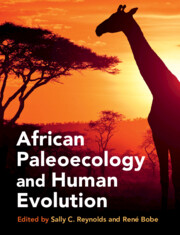Book contents
- African Paleoecology and Human Evolution
- African Paleoecology and Human Evolution
- Copyright page
- Dedication
- Contents
- Contributors
- Acknowledgments
- Part I Modern Africa and Overview of Late Cenozoic Paleoenvironments
- Part II Southern Africa
- Part III Eastern and Central Africa
- 15 Hominid Paleoenvironments in Tropical Africa from the Late Miocene to the Early Pleistocene
- 16 Mammal Paleoecology from the Late Early Pleistocene Sites of the Dandiero Basin (Eritrea), With Emphasis on the Suid Record
- 17 The 6-Million-Year Record of Ecological and Environmental Change at Gona, Afar Region, Ethiopia
- 18 The Hadar Formation, Afar Regional State, Ethiopia: Geology, Fauna, and Paleoenvironmental Reconstructions
- 19 Fossil Vertebrates and Paleoenvironments of the Pliocene Hadar Formation at Dikika, Ethiopia
- 20 Miocene to Pliocene Stratigraphy and Paleoecology of Galili, Ethiopia
- 21 Melka Kunture, Ethiopia: Early Pleistocene Faunas of the Ethiopian Highlands
- 22 Early Pleistocene Fauna and Paleoenvironments at Konso, Ethiopia
- 23 Paleontology and Geology of the Mursi Formation
- 24 Mammalian Diversity Patterns and Paleoecology in the Lower Omo Valley, Ethiopia
- 25 Paleoecology and Paleoenvironments of Early Quaternary Faunal Assemblages from the Nachukui Formation in Kenya: Insights from the West Turkana Archeological Project
- 26 Early Hominins and Paleoecology of the Koobi Fora Formation, Lake Turkana Basin, Kenya
- 27 Early Pliocene Faunal Assemblages from the Tugen Hills, Kenya: A Comparison of Field Collection Methods and Some Implications for Paleoenvironmental Reconstruction
- 28 The Southern Chemeron Formation, Tugen Hills, Kenya: A Review and a Paleoecological Analysis of the Bovid Fauna
- 29 Fauna and Paleoenvironments of the Homa Peninsula, Western Kenya
- 30 Mammalian Fauna of the Olorgesailie Basin and Southern Kenya Rift
- 31 Context and Environments of the Lower Pleistocene Hominins of Peninj, Tanzania
- 32 Paleoecology and Vertebrate Taphonomy of DK Site (Bed I), Olduvai Gorge, Tanzania
- 33 Lower Bed II Olduvai Basin, Tanzania: Wetland Sedge Taphonomy, Seasonal Pasture, and Implications for Hominin Scavenging
- 34 Paleoecology of Laetoli, Tanzania
- 35 The Paleoenvironment of the Plio-Pleistocene Chiwondo Beds of Northern Malawi
- Part IV Northern Africa
- Volume References
- Index
- Plate Section (PDF Only)
18 - The Hadar Formation, Afar Regional State, Ethiopia: Geology, Fauna, and Paleoenvironmental Reconstructions
from Part III - Eastern and Central Africa
Published online by Cambridge University Press: 19 May 2022
- African Paleoecology and Human Evolution
- African Paleoecology and Human Evolution
- Copyright page
- Dedication
- Contents
- Contributors
- Acknowledgments
- Part I Modern Africa and Overview of Late Cenozoic Paleoenvironments
- Part II Southern Africa
- Part III Eastern and Central Africa
- 15 Hominid Paleoenvironments in Tropical Africa from the Late Miocene to the Early Pleistocene
- 16 Mammal Paleoecology from the Late Early Pleistocene Sites of the Dandiero Basin (Eritrea), With Emphasis on the Suid Record
- 17 The 6-Million-Year Record of Ecological and Environmental Change at Gona, Afar Region, Ethiopia
- 18 The Hadar Formation, Afar Regional State, Ethiopia: Geology, Fauna, and Paleoenvironmental Reconstructions
- 19 Fossil Vertebrates and Paleoenvironments of the Pliocene Hadar Formation at Dikika, Ethiopia
- 20 Miocene to Pliocene Stratigraphy and Paleoecology of Galili, Ethiopia
- 21 Melka Kunture, Ethiopia: Early Pleistocene Faunas of the Ethiopian Highlands
- 22 Early Pleistocene Fauna and Paleoenvironments at Konso, Ethiopia
- 23 Paleontology and Geology of the Mursi Formation
- 24 Mammalian Diversity Patterns and Paleoecology in the Lower Omo Valley, Ethiopia
- 25 Paleoecology and Paleoenvironments of Early Quaternary Faunal Assemblages from the Nachukui Formation in Kenya: Insights from the West Turkana Archeological Project
- 26 Early Hominins and Paleoecology of the Koobi Fora Formation, Lake Turkana Basin, Kenya
- 27 Early Pliocene Faunal Assemblages from the Tugen Hills, Kenya: A Comparison of Field Collection Methods and Some Implications for Paleoenvironmental Reconstruction
- 28 The Southern Chemeron Formation, Tugen Hills, Kenya: A Review and a Paleoecological Analysis of the Bovid Fauna
- 29 Fauna and Paleoenvironments of the Homa Peninsula, Western Kenya
- 30 Mammalian Fauna of the Olorgesailie Basin and Southern Kenya Rift
- 31 Context and Environments of the Lower Pleistocene Hominins of Peninj, Tanzania
- 32 Paleoecology and Vertebrate Taphonomy of DK Site (Bed I), Olduvai Gorge, Tanzania
- 33 Lower Bed II Olduvai Basin, Tanzania: Wetland Sedge Taphonomy, Seasonal Pasture, and Implications for Hominin Scavenging
- 34 Paleoecology of Laetoli, Tanzania
- 35 The Paleoenvironment of the Plio-Pleistocene Chiwondo Beds of Northern Malawi
- Part IV Northern Africa
- Volume References
- Index
- Plate Section (PDF Only)
Summary
Fossiliferous sediments of the Hadar Formation (Afar, Ethiopia) are preserved in the Hadar, Dikika, Gona, and Ledi-Geraru research areas, and have produced the most informative record of the mid-Pliocene hominin Australopithecus afarensis. Hundreds of specimens of A. afarensis have been recovered from the Hadar site, including a partial skeleton (A.L. 288–1), two nearly complete adult skulls (A.L. 444–2; A.L. 822–1), and a dense accumulation of hominin individuals of various ages (A.L. 333; Johanson et al., 1978b; Kimbel et al., 1994; Kimbel and Delezene, 2009). Across the Awash River at Dikika, a juvenile hominin skeleton (DIK-1–1) was recovered and possible evidence of hominin carnivory ~3.4 Ma based on cut-marked bone was reported from Hadar Formation sediments (Alemseged et al., 2006; McPherron et al., 2010; Thompson et al., 2015). Thus, the outcrops of the Hadar Formation, particularly those at Hadar, have been tremendously important in interpreting Pliocene hominin evolution in eastern Africa.
- Type
- Chapter
- Information
- African Paleoecology and Human Evolution , pp. 214 - 228Publisher: Cambridge University PressPrint publication year: 2022



